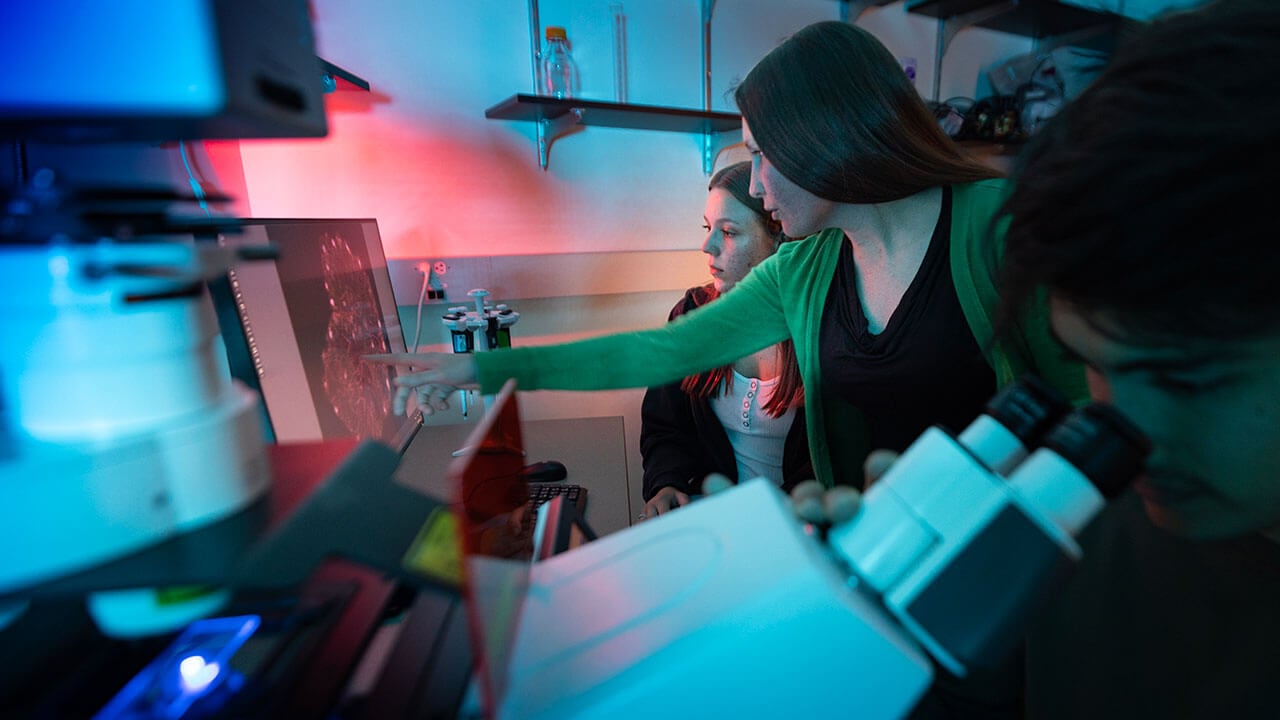
Biology professor earns grant totaling more than $180,000
December 18, 2023

December 18, 2023

The grant, awarded by the National Institute of General Medical Sciences, consists of about $49,482 distributed per year through March 31, 2027, and totaling more than $180,000.
Assistant Professor of Biology Caitlin Hanlon’s research will be supported through this grant, specifically her project titled “G-protein coupled receptors (GPCRs) signaling during embryonic organ formation.” Hanlon will work with The Johns Hopkins University School of Medicine as part of the grant.
“I spend a lot of my time wondering about embryos — in particular, the fruit fly embryo. Fruit flies are quite different from humans in many ways, but genetically, we are about 60% the same. This means that by studying genes in fruit flies, we can gain a better understanding of genes in humans,” Hanlon said. “The goals of this work are to understand the genes that influence how tissues and cells navigate to the correct place in a developing embryo.”
Hanlon expressed her appreciation for the opportunity to be able to continue her research through this grant, and the opportunities that will come from it.
“The most exciting thing about this research is the opportunity to develop a more complete picture of what these receptors are doing in the embryo. There are 116 G-protein coupled receptors encoded in the fruit fly genome, and until we began this work, only a handful of them had been studied for their potential to impact tissue migration. This means that there is a lot to discover, which is incredibly exciting,” Hanlon said.
Hanlon learned about the grant through her graduate adviser, Deborah Andrew, associate director for faculty development at the Institute for Basic Biomedical Sciences and professor of cell biology at The Johns Hopkins University.
“She recognized that this grant could be beneficial for both of us: It would allow her group at Johns Hopkins to continue the in-depth research that they specialize in, and it would give my group the resources to dedicate our time and efforts to a genetic screen,” Hanlon said.
The dedicated support from Maureen McCarthy, executive director of The Office of Research and Sponsored Programs (ORSP) at Quinnipiac, has been instrumental in propelling grant initiatives at the university.
ORSP plays a crucial role in distributing grants and overseeing sponsored research initiatives across the university. Working in collaboration with all nine schools and non-academic units, it closely partners with the controller’s office to guarantee the integrity of grant administration.
“Our grants portfolio at Quinnipiac has grown exponentially over the past four years, driven by the innovation and passion of our Quinnipiac faculty and staff. At the end of last fiscal year, ORSP was managing a portfolio of $7.5 million worth of grants, up from $4.08 million in fiscal year 2022 — and we continue to grow,” McCarthy said. “I feel very lucky to work with talented and accomplished colleagues like Professor Hanlon.”
As Quinnipiac’s impressive portfolio continues to grow, Provost Debra Liebowitz noted that these are all integral parts to the university’s strategic plan.
“Supporting faculty to develop their scholarly and creative endeavors is a critical part of the university’s strategic work,” Liebowitz said.
This continued support and collaboration sets the stage for unprecedented research.
“Many of these genes have never been studied before; in fact, some of the genes don’t even have a name yet,” Hanlon said. “The beauty of basic research is that we get to investigate broad questions and see where the results lead us. Through this work, we will gain insights into the role of these genes in the fruit fly, which in turn may give us hints as to what these genes are doing in humans.”
This grant will not only help contribute to Hanlon’s research, but Quinnipiac students will be able to benefit as well.
“This research is also the foundation for the laboratory component of BIO-346: Cell Physiology. The lab is organized as a course-based undergraduate research experience (CURE). The great part about this approach is that it brings authentic research to students in the classroom,” Hanlon said.
This opportunity for research is one of the many ways that students are able to take advantage of experiential learning.
”When I started graduate school, I never envisioned myself as a fruit fly biologist or a geneticist,” Hanlon said. “It was really cool to know that I could make discoveries and advance scientific knowledge with my work, and I hope to bring the same opportunities and excitement to students who work in my lab.”
Both undergraduate and graduate students are deeply involved with this work. In Hanlon’s lab, students choose a gene to study and learn how to study the effects it has on tissue migration in the embryo.
Hanlon explains that her students are already making astonishing findings.
“Students learn skills such as animal husbandry, immunohistochemistry, and data analysis, which are skills that they can use in academic research labs or in industry,” Hanlon said. “We’ve already had some exciting preliminary results from this work: several genes that my students have identified as ‘hits’ in the screen (meaning they are GPCRs that we have identified as affecting tissue migration) have been confirmed in other labs, meaning that our work is already contributing novel findings to the scientific community.”
Any students who are interested in this work are encouraged to reach out to Hanlon at Caitlin.Hanlon@quinnipiac.edu and, in Hanlon’s words, “Get ready to delve into the world of developmental biology!”
Quinnipiac Today is your source for what's happening throughout #BobcatNation. Sign up for our weekly email newsletter to be among the first to know about news, events and members of our Bobcat family who are making a positive difference in our world.
Sign Up Now